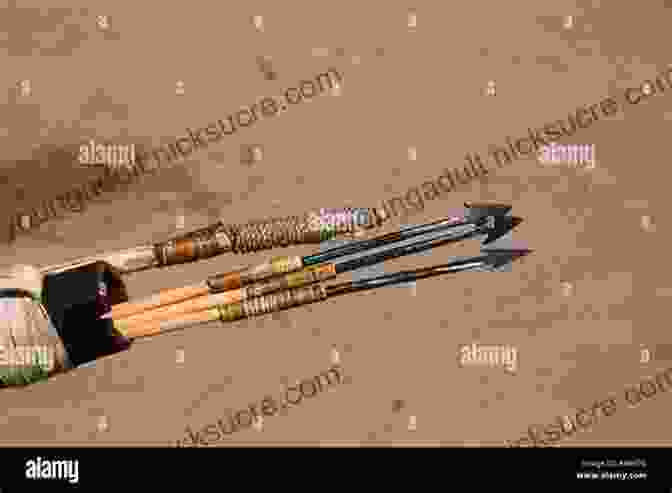Poison Arrows: A Comprehensive Exploration of North American Indian Hunting and Warfare Techniques


In the annals of hunting and warfare, poison arrows have occupied a unique and formidable place. For centuries, Native Americans across North America wielded these deadly projectiles, infusing them with potent toxins that could paralyze or even kill their targets. This article delves into the captivating world of poison arrows, exploring their origins, construction, and the strategic prowess they bestowed upon their creators.
Origins and Geographical Distribution
The use of poison arrows has a long and widespread history among North American Indian tribes. Archaeological evidence suggests that the practice originated as early as 8,000 years ago, with tribes in the Great Basin and Southwest regions being among the first to adopt this technique. Over time, the use of poison arrows spread to tribes in the Plains, Eastern Woodlands, and Pacific Northwest.
4.8 out of 5
| Language | : | English |
| File size | : | 3148 KB |
| Text-to-Speech | : | Enabled |
| Screen Reader | : | Supported |
| Enhanced typesetting | : | Enabled |
| Print length | : | 156 pages |
| Lending | : | Enabled |
Poison Sources and Preparation
The poisons used on arrows varied depending on the region and the available resources. Plant sources were the most common, with tribes using a wide range of toxic plants to create their arrow poisons. Some of the most notable plant sources included monkshood, water hemlock, and poison ivy. Animal sources were also used, particularly the venom of venomous snakes and scorpions.
The preparation of arrow poisons was a complex and often secretive process. Plant materials were typically crushed, boiled, or fermented to extract their toxic compounds. Animal venoms were collected and dried or mixed with plant extracts to increase their potency. The resulting concoctions were then applied to arrowheads, often using a mixture of grease or resin to enhance adhesion.
Arrow Construction
The construction of poison arrows required great skill and attention to detail. Arrow shafts were typically made from lightweight woods such as cedar or cane, with the ends carefully tapered to create a smooth flight path. The arrowheads were meticulously crafted from stone, bone, or antler, with sharp points designed to penetrate flesh and deliver the poison effectively.
The poison was applied to the arrowhead using various methods. Some tribes simply dipped the arrowhead into the poison mixture, while others used a brush or a small stick to apply a precise amount of poison. The quantity and potency of the poison varied depending on the intended target and the hunting or warfare strategy.
Hunting and Warfare Strategies
Poison arrows were primarily used for hunting large game animals, such as deer, elk, and bison. The arrows were typically shot from short distances, ensuring accuracy and maximizing the impact of the poison. Hunters would often use stealth and camouflage techniques to get close to their prey before launching their arrows.
In warfare, poison arrows were a formidable weapon, capable of inflicting debilitating wounds or even death on enemy combatants. Tribes would often use poison arrows in conjunction with other weapons, such as bows, spears, and clubs, to gain an advantage in battle. The psychological impact of poison arrows was also significant, as warriors feared the agonizing pain and potential fatality associated with being hit by a poisoned arrow.
Cultural Significance
Beyond their practical applications, poison arrows held deep cultural significance for many North American Indian tribes. They were often associated with warfare, hunting prowess, and spiritual beliefs. Some tribes believed that the use of poison arrows gave them a supernatural advantage over their enemies.
The construction and use of poison arrows were often passed down through generations, with skilled arrow makers being highly respected within their communities. The knowledge of poison arrow preparation and the ability to wield them effectively were considered valuable assets, contributing to the survival and success of the tribe.
Decline and Modern Use
With the arrival of European settlers in North America, the use of poison arrows gradually declined. European laws and regulations prohibited the use of poison arrows in warfare, and the of firearms provided a more efficient and less hazardous alternative for hunting.
Today, the use of poison arrows is largely confined to ceremonial purposes or traditional hunting practices in remote areas. However, the legacy of poison arrows continues to fascinate historians, anthropologists, and enthusiasts alike, providing a glimpse into the ingenuity, skill, and cultural traditions of North American Indians.
Poison arrows were a powerful and versatile tool employed by North American Indians for centuries. Their deadly efficacy, intricate construction, and cultural significance made them a formidable weapon in hunting and warfare. From the earliest archaeological evidence to the present day, poison arrows have played a captivating role in the history and traditions of Native American communities. As we delve deeper into their secrets and appreciate their historical significance, we gain a greater understanding of the ingenuity, resilience, and cultural diversity of the peoples who crafted and wielded these deadly projectiles.
4.8 out of 5
| Language | : | English |
| File size | : | 3148 KB |
| Text-to-Speech | : | Enabled |
| Screen Reader | : | Supported |
| Enhanced typesetting | : | Enabled |
| Print length | : | 156 pages |
| Lending | : | Enabled |
Do you want to contribute by writing guest posts on this blog?
Please contact us and send us a resume of previous articles that you have written.
 Fiction
Fiction Non Fiction
Non Fiction Romance
Romance Mystery
Mystery Thriller
Thriller SciFi
SciFi Fantasy
Fantasy Horror
Horror Biography
Biography Selfhelp
Selfhelp Business
Business History
History Classics
Classics Poetry
Poetry Childrens
Childrens Young Adult
Young Adult Educational
Educational Cooking
Cooking Travel
Travel Lifestyle
Lifestyle Spirituality
Spirituality Health
Health Fitness
Fitness Technology
Technology Science
Science Arts
Arts Crafts
Crafts DIY
DIY Gardening
Gardening Petcare
Petcare Christopher Nyerges
Christopher Nyerges W Todd Woodard
W Todd Woodard Greg Prato
Greg Prato Ruth Benedict
Ruth Benedict Eugene P Northrop
Eugene P Northrop Michele Borba
Michele Borba Christian Heath
Christian Heath Robb Manning
Robb Manning Ben Ehrenreich
Ben Ehrenreich Karl E Peace
Karl E Peace Jessica Nordell
Jessica Nordell Belinda Norton
Belinda Norton Gerard Siggins
Gerard Siggins David Goodman
David Goodman John Geiger
John Geiger Fredrik Backman
Fredrik Backman Kathryn Miles
Kathryn Miles Nathaniel Rich
Nathaniel Rich Angel Millar
Angel Millar Tim Macwelch
Tim Macwelch Scott Meyer
Scott Meyer Mark Synnott
Mark Synnott Alex Wolf
Alex Wolf Mark Shepherd
Mark Shepherd Robert Zubek
Robert Zubek Bob Gordon
Bob Gordon Kari Marie Norgaard
Kari Marie Norgaard George Noory
George Noory Judith S Beck
Judith S Beck Caryl Say
Caryl Say Rebecca Serle
Rebecca Serle Adam Skolnick
Adam Skolnick Angela Leslee
Angela Leslee Scott Stillman
Scott Stillman Patrick Ejeke
Patrick Ejeke Daddilife Books
Daddilife Books Tj Faultz
Tj Faultz Stephen Rea
Stephen Rea Stephen Lynch
Stephen Lynch Liv Ryan
Liv Ryan Violet White
Violet White Miranda Green
Miranda Green Baby Professor
Baby Professor Cory Mortensen
Cory Mortensen Mark Wells
Mark Wells Patrick Pickens
Patrick Pickens Stephen Jungmann
Stephen Jungmann Gary B Meisner
Gary B Meisner Israelin Shockness
Israelin Shockness Andy Mitchell
Andy Mitchell Diana Winston
Diana Winston Lindsay Ford
Lindsay Ford Peter Townsend
Peter Townsend Steve Hindman
Steve Hindman Nicholas Jubber
Nicholas Jubber Sam Bleakley
Sam Bleakley Judith Hoare
Judith Hoare Angela Eckhoff
Angela Eckhoff Robert E Stake
Robert E Stake Eli Wilson
Eli Wilson Rodney Paul
Rodney Paul Mike Chambers
Mike Chambers Tim Thayne
Tim Thayne Laura Bogen
Laura Bogen Andy Dowsett
Andy Dowsett Muako Maepa
Muako Maepa Kristina Statler
Kristina Statler R E Burrillo
R E Burrillo Ben Campbell
Ben Campbell Donna Helen Crisp Jd Msn Rn Pmhcns Bc
Donna Helen Crisp Jd Msn Rn Pmhcns Bc Ariel Henley
Ariel Henley Derek M Steinbacher
Derek M Steinbacher Ray Walker
Ray Walker Kent David Kelly
Kent David Kelly Dan Ariely
Dan Ariely Bradley Charbonneau
Bradley Charbonneau Mark Verstegen
Mark Verstegen Lois A Ritter
Lois A Ritter Pete Sampras
Pete Sampras Laura Hillman
Laura Hillman Mometrix
Mometrix George Johnson
George Johnson Mark Kernion
Mark Kernion Carol Ann Gillespie
Carol Ann Gillespie S L Macgregor Mathers
S L Macgregor Mathers Dave Duncan
Dave Duncan Mark J Musser
Mark J Musser Nicole Smith
Nicole Smith Bret A Moore
Bret A Moore Diana Nyad
Diana Nyad Margaret M Quinlan
Margaret M Quinlan Marie Brennan
Marie Brennan Tovar Cerulli
Tovar Cerulli Louis Martin
Louis Martin Karen Elliott House
Karen Elliott House Walter Beede
Walter Beede Chip Heath
Chip Heath Avinash Navlani
Avinash Navlani Erin Moulton
Erin Moulton Rebecca Boggs Roberts
Rebecca Boggs Roberts Tanya Lee Stone
Tanya Lee Stone Stuart Lawrence
Stuart Lawrence Jay Griffiths
Jay Griffiths Rob Willson
Rob Willson Jeremy Klaff
Jeremy Klaff Carlos Acevedo
Carlos Acevedo G K Derosa
G K Derosa Joseph Phillips
Joseph Phillips Chef Maggie Chow
Chef Maggie Chow Mark Remy
Mark Remy Tom Allen
Tom Allen Margaret Visser
Margaret Visser Peter Gibson
Peter Gibson Jay Matthews
Jay Matthews Emma Dalton
Emma Dalton Arlin Smith
Arlin Smith Emiko Jean
Emiko Jean Ingrid S Clay
Ingrid S Clay T L Payne
T L Payne Ashley Rickards
Ashley Rickards James Quinn
James Quinn Robin Ray Green
Robin Ray Green John B Nici
John B Nici Yvonne Choquet Bruhat
Yvonne Choquet Bruhat Marc Charles
Marc Charles Wynne Foster
Wynne Foster Joyce Yang
Joyce Yang Ryan D Agostino
Ryan D Agostino Sir Edmund Hillary
Sir Edmund Hillary Shenila Khoja Moolji
Shenila Khoja Moolji Humberto G Garcia
Humberto G Garcia Sharon Strand Ellison
Sharon Strand Ellison Jim Saccomano
Jim Saccomano Jeff Fleischer
Jeff Fleischer Tigran Bagdasaryan
Tigran Bagdasaryan Andy Peloquin
Andy Peloquin Angela C Wu
Angela C Wu David Herres
David Herres Jeff Mach
Jeff Mach Barry Pickthall
Barry Pickthall Angela Stancar Johnson
Angela Stancar Johnson David E Jones
David E Jones Shreya Ramachandran
Shreya Ramachandran Murtaza Haider
Murtaza Haider Meg Long
Meg Long Jo May
Jo May D M Davis
D M Davis Andy Farrell
Andy Farrell John Samuel Barnett
John Samuel Barnett Joel J Lerner
Joel J Lerner Robyn Ryle
Robyn Ryle Petros Efthymiou
Petros Efthymiou Harry Fairhead
Harry Fairhead Robert Urban
Robert Urban Kenneth R Ginsburg
Kenneth R Ginsburg Andy Tyson
Andy Tyson Hajime Isayama
Hajime Isayama Michael Anthony
Michael Anthony William D Lopez
William D Lopez Samir P Desai
Samir P Desai Mark Lester
Mark Lester Howell Raines
Howell Raines Afra J Zomorodian
Afra J Zomorodian Stewart Shapiro
Stewart Shapiro Rufus Estes
Rufus Estes Mary Pipher
Mary Pipher Jenna Helwig
Jenna Helwig Dean Beaumont
Dean Beaumont Robyn Harding
Robyn Harding Tara Sim
Tara Sim Richard A Muller
Richard A Muller Stacy Mccullough
Stacy Mccullough William Ayers
William Ayers Charney Herst
Charney Herst Jerry Toner
Jerry Toner Linda Sivertsen
Linda Sivertsen Joy Williams
Joy Williams Oliver Burkeman
Oliver Burkeman Karl Beecher
Karl Beecher Angelo Tropea
Angelo Tropea Harold S Koplewicz
Harold S Koplewicz Howard Davis
Howard Davis Nicholas Epley
Nicholas Epley Richard Bate
Richard Bate Brian Cain
Brian Cain Cap N Fatty Goodlander
Cap N Fatty Goodlander Rachel Hutt Phd
Rachel Hutt Phd Ryan Beck
Ryan Beck Kevin Thomas
Kevin Thomas Tovah Feldshuh
Tovah Feldshuh Shalabh Aggarwal
Shalabh Aggarwal Bernd Heinrich
Bernd Heinrich Chris Santella
Chris Santella Miles Olson
Miles Olson Robert Kirk
Robert Kirk Nicholas D Kristof
Nicholas D Kristof Tom Dymond
Tom Dymond Cynthia Nims
Cynthia Nims Joe Peta
Joe Peta Matt Vincent
Matt Vincent John Sonmez
John Sonmez Manik Joshi
Manik Joshi Keith Crowley
Keith Crowley Warren Sande
Warren Sande Jim Posewitz
Jim Posewitz Stephen Grossberg
Stephen Grossberg Dan Heath
Dan Heath Johnson Egonmwan
Johnson Egonmwan Tim O Connor
Tim O Connor Chris Chelios
Chris Chelios Christina Reese
Christina Reese Florian Freistetter
Florian Freistetter K Moriyasu
K Moriyasu Ron Jeffries
Ron Jeffries Dhonielle Clayton
Dhonielle Clayton Angeline Boulley
Angeline Boulley Karen Sternheimer
Karen Sternheimer Elizabeth Foss
Elizabeth Foss Sabbithry Persad Mba
Sabbithry Persad Mba Jason Hogan
Jason Hogan Jordan Summers
Jordan Summers Dennis Rainey
Dennis Rainey Ed Stafford
Ed Stafford Germano Dalcielo
Germano Dalcielo Lee Cronk
Lee Cronk Elizabeth Hunter
Elizabeth Hunter Anna Rashbrook
Anna Rashbrook Tiara Mcclure
Tiara Mcclure Caspar Melville
Caspar Melville Massimo Florio
Massimo Florio Kim Dragoner
Kim Dragoner Natalie Rhodes
Natalie Rhodes Madeleine Roux
Madeleine Roux Tristan Higbee
Tristan Higbee Elizabeth Kaledin
Elizabeth Kaledin Tania N Shah
Tania N Shah Judea Pearl
Judea Pearl Robyn Wideman
Robyn Wideman Third Edition Kindle Edition
Third Edition Kindle Edition Rachel Kowert
Rachel Kowert Ben Bleiweiss
Ben Bleiweiss Barak Ariel
Barak Ariel Angelina J Steffort
Angelina J Steffort David C Keehn
David C Keehn Mitch Horowitz
Mitch Horowitz Tea Rozman Clark
Tea Rozman Clark Mercedes Pollmeier
Mercedes Pollmeier Forrest Maready
Forrest Maready Jonah Lehrer
Jonah Lehrer Gregory J Davenport
Gregory J Davenport Tina Nelson
Tina Nelson Charlotte Klaar Phd
Charlotte Klaar Phd Mtg Editorial Board
Mtg Editorial Board Daniel Friedmann
Daniel Friedmann Stephen Cheney
Stephen Cheney Emily Nielson
Emily Nielson J D Swanson
J D Swanson Mirabai Starr
Mirabai Starr Keith Elliot Greenberg
Keith Elliot Greenberg Lisa Marie Mercer
Lisa Marie Mercer William Bryant Logan
William Bryant Logan Nikki Ace
Nikki Ace Kevin Hunter
Kevin Hunter Chuck Weikert
Chuck Weikert Ted Sandling
Ted Sandling Joshua Clark
Joshua Clark Kat Anderson
Kat Anderson Jeffrey T Richelson
Jeffrey T Richelson Michael V Uschan
Michael V Uschan Stefanie K Johnson
Stefanie K Johnson Christopher O Kennon
Christopher O Kennon Kathy Freston
Kathy Freston Jeffrey Thurston
Jeffrey Thurston Keylee C Hargis
Keylee C Hargis Matthew D Dewar
Matthew D Dewar Lawrence Goldstone
Lawrence Goldstone Rosie Daley
Rosie Daley Richard Lemaster
Richard Lemaster Latonya J Trotter
Latonya J Trotter Kate Le Roux
Kate Le Roux Deborah Wall
Deborah Wall Alessio Mangoni
Alessio Mangoni Scott Alan Johnston
Scott Alan Johnston Rashaun Johnson
Rashaun Johnson Mark W Steege
Mark W Steege James M Johnston
James M Johnston Wayne Mcghie
Wayne Mcghie Rachel Connelly
Rachel Connelly Shane O Mara
Shane O Mara Troy A Hill
Troy A Hill Rebecca Hemmings
Rebecca Hemmings Lisa Preston
Lisa Preston Samuel B Green
Samuel B Green Cheryl Alkon
Cheryl Alkon Christian Wiggins
Christian Wiggins Peter Finch
Peter Finch Richard Hibshman
Richard Hibshman Roland A Boucher
Roland A Boucher Neveen Musa
Neveen Musa Kim Foley Mackinnon
Kim Foley Mackinnon John C Maxwell
John C Maxwell Donna Mott
Donna Mott Jeffrey Bernstein
Jeffrey Bernstein Phil Burt
Phil Burt Patrick M Lencioni
Patrick M Lencioni Stephanie Land
Stephanie Land Emily Souder
Emily Souder Ellen Frank
Ellen Frank Kristen S Kurland
Kristen S Kurland Jessica Wolstenholm
Jessica Wolstenholm Jenna Blough
Jenna Blough Sylvester Nemes
Sylvester Nemes M J Fievre
M J Fievre Bill Schneider
Bill Schneider Katrina Cope
Katrina Cope Martin Volken
Martin Volken Otto Rahn
Otto Rahn Donald R Prothero
Donald R Prothero Frank Deford
Frank Deford Ryan Bow
Ryan Bow Frederick Aardema
Frederick Aardema Thais Nye Derich
Thais Nye Derich David Kinney
David Kinney Yuu Tanaka
Yuu Tanaka Dwight E Neuenschwander
Dwight E Neuenschwander T R Fehrenbach
T R Fehrenbach William E Hearn
William E Hearn Douglas Henderson Jr
Douglas Henderson Jr Rebecca P Cohen
Rebecca P Cohen United States Government Us Army
United States Government Us Army Joan Jacobs Brumberg
Joan Jacobs Brumberg Jenny Smith
Jenny Smith Andy Crowe
Andy Crowe Kevin J Gaston
Kevin J Gaston Bob Clouser
Bob Clouser Jessica Jung
Jessica Jung Hourly History
Hourly History Stefan Hunziker
Stefan Hunziker Serena B Miller
Serena B Miller Marilyn Burgos
Marilyn Burgos Siena Cherson Siegel
Siena Cherson Siegel Pete Dunne
Pete Dunne Jane M Healy
Jane M Healy George Megre
George Megre Lidia Bastianich
Lidia Bastianich Aaron Wilson
Aaron Wilson Chanel Craft Tanner
Chanel Craft Tanner Kristen Jervis Cacka
Kristen Jervis Cacka Lutz Hanseroth
Lutz Hanseroth Catherine Mccord
Catherine Mccord Andy Jurinko
Andy Jurinko Angelo Lowery
Angelo Lowery Warren St John
Warren St John Devaki Lakshmi
Devaki Lakshmi Ellen J Langer
Ellen J Langer David Graeber
David Graeber Madison Lee
Madison Lee Mark Rosenman
Mark Rosenman Thomas Golf
Thomas Golf Andy Schell
Andy Schell Richard G Brown
Richard G Brown Rawdon Wyatt
Rawdon Wyatt Rebecca Eanes
Rebecca Eanes Lucy Postgate
Lucy Postgate Lynn Lyons
Lynn Lyons Roger Craig
Roger Craig Robin Yocum
Robin Yocum Capn Fatty Goodlander
Capn Fatty Goodlander Marie Myung Ok Lee
Marie Myung Ok Lee Susan Burton
Susan Burton Schoolhouse Heaven
Schoolhouse Heaven Colby Coombs
Colby Coombs Thomas Gilovich
Thomas Gilovich Dr Eva Beaulieu
Dr Eva Beaulieu Bradley T Erford
Bradley T Erford Joe Berardi
Joe Berardi Dave Gray
Dave Gray Richard Lee Byers
Richard Lee Byers Carlo Rovelli
Carlo Rovelli Lin Wellford
Lin Wellford Ken Dryden
Ken Dryden Jules Brown
Jules Brown Dave Smith
Dave Smith Jim Prime
Jim Prime Seth Lloyd
Seth Lloyd Leanne Ely
Leanne Ely L S Boos
L S Boos Jodi Shabazz
Jodi Shabazz Paul Cobley
Paul Cobley Jennifer Bohnet
Jennifer Bohnet Michael Driscoll
Michael Driscoll Eric Schmitz
Eric Schmitz Christina Hillsberg
Christina Hillsberg Tim Larkin
Tim Larkin Beth A Leonard
Beth A Leonard Erich Fromm
Erich Fromm Wendy Rosenoff
Wendy Rosenoff Kelly Corrigan
Kelly Corrigan Scott Turner
Scott Turner Leonard Lueras
Leonard Lueras Neil Hawkesford
Neil Hawkesford Viviana Altuve
Viviana Altuve Andy Puddicombe
Andy Puddicombe Bob Swope
Bob Swope Margaret Jordan Halter
Margaret Jordan Halter Teresa Parker
Teresa Parker Elly Molina
Elly Molina Johnny Molloy
Johnny Molloy Rick Vaive
Rick Vaive Angel Burns
Angel Burns Angela Thayer
Angela Thayer Angela Smith
Angela Smith Dawn Griffiths
Dawn Griffiths Mandee Heller Adler
Mandee Heller Adler Rodney Castleden
Rodney Castleden Tirzah Price
Tirzah Price Tim Hannigan
Tim Hannigan Jonathan Gottschall
Jonathan Gottschall Jon Ronson
Jon Ronson Eliot Schrefer
Eliot Schrefer Joseph Mazur
Joseph Mazur Julia Reed
Julia Reed Angelo Chiari
Angelo Chiari Janet Menzies
Janet Menzies Ashley P Martin
Ashley P Martin Sam Fury
Sam Fury Richard L Sites
Richard L Sites Michael Tomasello
Michael Tomasello Jeanne Godfrey
Jeanne Godfrey Irene Gut Opdyke
Irene Gut Opdyke Kim West
Kim West Cate Tiernan
Cate Tiernan Danil Zburivsky
Danil Zburivsky Andrea Lankford
Andrea Lankford Tom Chatfield
Tom Chatfield Jamie Kuykendall
Jamie Kuykendall Raynor Winn
Raynor Winn Gillian Price
Gillian Price Robert Dudley
Robert Dudley Sandy Tolan
Sandy Tolan Kyle Graves
Kyle Graves Sandra Steingraber
Sandra Steingraber Alberta Hawse
Alberta Hawse Connie Schultz
Connie Schultz Ruby Lang
Ruby Lang Robert Lindsay
Robert Lindsay Milton Roth
Milton Roth George E Hein
George E Hein Guy Evans
Guy Evans Nick Bradley
Nick Bradley Donald N Yates
Donald N Yates Rebecca Solnit
Rebecca Solnit Ron Douglas
Ron Douglas Jeffrey Lee
Jeffrey Lee Rafael Gordillo Naranjo
Rafael Gordillo Naranjo Jodi Picoult
Jodi Picoult Lynn Palm
Lynn Palm Rod Powers
Rod Powers Robin Benway
Robin Benway Kathy Hoopmann
Kathy Hoopmann Jorge Ramos Mizael
Jorge Ramos Mizael
Light bulbAdvertise smarter! Our strategic ad space ensures maximum exposure. Reserve your spot today!

 Matthew WardComprehensive Guide to Pregnancy Diets and Nutrition: A Journey for Maternal...
Matthew WardComprehensive Guide to Pregnancy Diets and Nutrition: A Journey for Maternal...
 DeShawn PowellNurse Practitioners: Essential Healthcare Providers Who Address Critical...
DeShawn PowellNurse Practitioners: Essential Healthcare Providers Who Address Critical... Walter SimmonsFollow ·17.2k
Walter SimmonsFollow ·17.2k Ron BlairFollow ·7.1k
Ron BlairFollow ·7.1k Yasunari KawabataFollow ·2.5k
Yasunari KawabataFollow ·2.5k Deacon BellFollow ·4.5k
Deacon BellFollow ·4.5k Ivan CoxFollow ·6.4k
Ivan CoxFollow ·6.4k Rob FosterFollow ·14.2k
Rob FosterFollow ·14.2k Gabriel BlairFollow ·7k
Gabriel BlairFollow ·7k Percy Bysshe ShelleyFollow ·17k
Percy Bysshe ShelleyFollow ·17k

 Devon Mitchell
Devon MitchellDelve into the Comprehensive World of Cartridges: A...
In the realm of firearms, cartridges stand...

 Joseph Conrad
Joseph ConradTales From The San Francisco 49ers Sideline: A Look...
The San Francisco 49ers are one of the most...

 Ervin Bell
Ervin BellArcGIS Desktop 10: A Comprehensive GIS Tutorial for...
Geographic information...

 Reed Mitchell
Reed MitchellPhysiology Pretest Self Assessment And Review 14th...
Accurately gauge your physiology knowledge and...

 Devin Ross
Devin RossLost At Sea: The Unbelievable True Story of the Jon...
In 2009, journalist Jon Ronson set out to...

 Shane Blair
Shane BlairModes of Thinking for Qualitative Data Analysis
Qualitative data analysis is a complex...
4.8 out of 5
| Language | : | English |
| File size | : | 3148 KB |
| Text-to-Speech | : | Enabled |
| Screen Reader | : | Supported |
| Enhanced typesetting | : | Enabled |
| Print length | : | 156 pages |
| Lending | : | Enabled |








